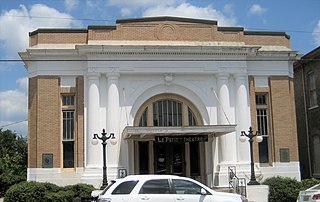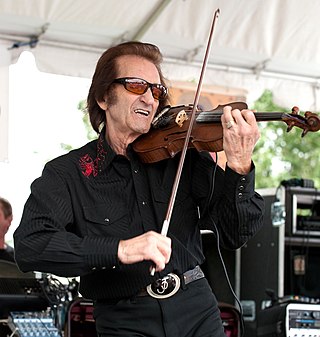
The Cajuns, also known as Louisiana Acadians, are a Louisiana French ethnicity mainly found in the U.S. state of Louisiana and surrounding Gulf Coast states.

Louisiana Story is a 1948 American black-and-white drama film directed and produced by Robert J. Flaherty. Its script was written by Frances H. Flaherty and Robert J. Flaherty. Although it has historically been represented as a documentary film, the events and characters depicted are fictional. There is not enough factual or educational material in the film to warrant classifying it as docufiction. The film was commissioned by the Standard Oil Company to promote its drilling ventures in the Louisiana bayous.

Terrebonne Parish is a parish located in the southern part of the U.S. state of Louisiana. At the 2020 census, the population was 109,580. The parish seat is Houma. The parish was founded in 1822. Terrebonne Parish is part of the Houma-Thibodaux metropolitan statistical area.

Loreauville is a village in Iberia Parish in the U.S. state of Louisiana. The population was 887 at the 2010 census, down from 938 at the 2000 census. It is part of the New Iberia micropolitan statistical area, and the Lafayette metropolitan statistical area.
Galliano is an unincorporated community and census-designated place (CDP) on the Bayou Lafourche in Lafourche Parish, Louisiana, United States. As of 2020, its population was 7,100. It is part of the Houma–Bayou Cane–Thibodaux metropolitan statistical area.

Thibodaux is a city in, and the parish seat of, Lafourche Parish, Louisiana, United States, along the banks of Bayou Lafourche in the northwestern part of the parish. The population was 15,948 at the 2020 census. Thibodaux is a principal city of the Houma–Bayou Cane–Thibodaux metropolitan statistical area.

St. Martinville is a city in and the parish seat of St. Martin Parish, Louisiana, United States. It lies on Bayou Teche, 13 miles (21 km) south of Breaux Bridge, 16 miles (26 km) southeast of Lafayette, and 9 miles (14 km) north of New Iberia. The population was 6,114 at the 2010 U.S. census, and 5,379 at the 2020 United States census. It is part of the Lafayette metropolitan statistical area.

Houma is the largest city in and the parish seat of Terrebonne Parish in the U.S. state of Louisiana. It is also the largest principal city of the Houma–Bayou Cane–Thibodaux metropolitan statistical area. The city's government was absorbed by the parish in 1984, which currently operates as the Terrebonne Parish Consolidated Government.

Douglas James Kershaw is an American fiddle player, singer and songwriter from Louisiana. Active since 1948, he began his career as part of the duo Rusty and Doug, along with his brother, Rusty Kershaw. He had an extensive solo career that included fifteen albums and singles that charted on the Hot Country Songs charts. He is also a member of the Louisiana Music Hall of Fame, being inducted in 2009.

Douglas Fowley was an American movie and television actor in more than 240 films and dozens of television programs, He is probably best remembered for his role as the frustrated movie director Roscoe Dexter in Singin' in the Rain (1952), and for his regular supporting role as Doc Holliday in The Life and Legend of Wyatt Earp. He was the father of rock and roll musician and record producer Kim Fowley.

Timothy Agoglia Carey was an American film and television character actor who was typically cast as manic or violent characters who are driven to extremes. He is particularly known for his collaborations with Stanley Kubrick in the films The Killing (1956) and Paths of Glory (1957), and for appearing in the two John Cassavetes directed films Minnie and Moskowitz (1971) and The Killing of a Chinese Bookie (1976). Other notable film credits include Crime Wave (1954), East of Eden (1955), One-Eyed Jacks (1961), Beach Blanket Bingo (1965), Head (1968) and The Outfit (1973).

Sandy West was an American singer, drummer and songwriter. She was one of the founding members of The Runaways, the first teenage all-girl hard rock band to record and achieve widespread commercial success in the 1970s.

Hurricane on the Bayou is an American 2006 documentary film that focuses on the wetlands of Louisiana before and after Hurricane Katrina.

Amanda Christian Amaya-Shaw is an American Cajun fiddler, singer, and actress from Mandeville, Louisiana. She was inducted into the Louisiana Music Hall of Fame in 2020.
The Cajun French Music Association is an association dedicated to the promotion and preservation of Cajun music and culture.

Cajun music has its roots based in the ballads of the French-speaking Acadians of Canada, and in country music.
Glen Anthony Pitre is an American screenwriter and film director. He has written nine films since 1986. His debut film Belizaire the Cajun was screened in the Un Certain Regard section at the 1986 Cannes Film Festival.
Hayes is an unincorporated community and census-designated place (CDP) located in Calcasieu Parish, Louisiana, United States. As of the 2010 census it had a population of 780. It is part of the Lake Charles Metropolitan Statistical Area.
Daniel LeBlanc was an early settler of the Port Royal area of Acadia, in what is now Canada and the United States, and ancestor to many LeBlancs.

Charlene Marie Richard was a twelve-year-old Roman Catholic Cajun girl from Richard, Louisiana, in the United States. She has become the focus of a popular belief that she has performed a number of miracles. Local Catholic clergy and diocesan officials permitted, promoted, and participated in the popular veneration of Richard for years prior to her being named a Servant of God.















